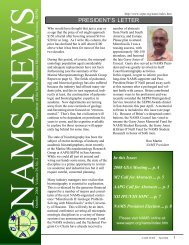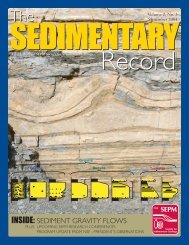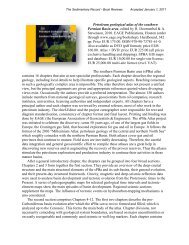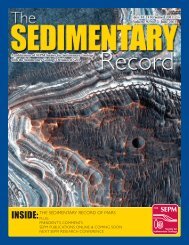PDF of contents and abstracts - SEPM
PDF of contents and abstracts - SEPM
PDF of contents and abstracts - SEPM
You also want an ePaper? Increase the reach of your titles
YUMPU automatically turns print PDFs into web optimized ePapers that Google loves.
valleys produces sequence boundaries that are infrequently flooded across interfluve areas. Fluvial<br />
aggradational cycles across interfluve positions are much thinner than average <strong>and</strong> are characterized by<br />
the most well-developed <strong>and</strong> best-drained paleosols.<br />
Application <strong>of</strong> the alluvial stacking pattern methodology is demonstrated within three case studies. Case<br />
study 1, from Big Bend National Park, Texas, considers a latest Cretaceous to earliest Tertiary passive<br />
margin <strong>and</strong> coastal plain succession <strong>and</strong> correlates alluvial sequences <strong>and</strong> associated climate <strong>and</strong><br />
ecosystem changes to eustatic sea-level oscillations. Case study 2, from northern <strong>and</strong> northeastern New<br />
Mexico, documents a Late Triassic forel<strong>and</strong> basin succession in which tectonically induced<br />
accommodation events are correlated between isolated outcrop successions that are located 200 km apart.<br />
Case study 3, from central New York, demonstrates how stacking pattern analysis allows correlation <strong>of</strong> a<br />
Middle Devonian alluvial composite sequence with equivalent regressive–transgressive marine strata<br />
along a convergent plate boundary.






